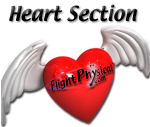FAA Disease Protocol:
|
|
There are many nuances to the complex topic of coronary heart disease (CHD), also called coronary artery disease (CAD) and atherosclerotic heart disease. Although you will see inconsistent terminology, we will use the FAA terminology of Coronary Heart Disease (CHD) and it is critical that pilots and others understand this life-threatening disease process, and FlightPhysical.com provides a CHD Checklist to help you and your AME collect the necessary paperwork and tests needed to reapply for aeromedical certification. CHD is the end result of the accumulation of atheromatous plaques within the walls of the coronary arteries that supply the myocardium (the muscle of the heart). While the symptoms and signs of coronary heart disease are noted in the advanced state of disease, most individuals with coronary heart disease show no evidence of disease for decades as the disease progresses before the first onset of symptoms, often a "sudden" heart attack, finally arise. This is why this is such a critical topic for pilots.
After decades of progression, some of these atheromatous plaques may rupture and (along with the activation of the blood clotting system) start limiting blood flow to the heart muscle. The disease is the most common cause of sudden death. Most Common reason for death of Men or woman over 65 years of Age. Please note that the FAA has adopted the term Coronary Heart Disease to refer to this category of heart problems. There are other problems such as congestive heart failure (CHF) or valve problems that may be related to or caused by your coronary heart disease, but valve problems are discussed elsewhere. This part of FlightPhysical.com is meant to help you understand the FAA approach to Myocardial infarction, angina pectoris, or other findings which suggest or provide evidence that the pilot applicant has coronary heart disease as described in the FAA protocol. As always, pilots are advised to seek interpretative help from their AME. Find and AME. The pilot's medical reports and test results relating to the diagnosis of must be obtained and routed through your AME to the Aerospace Medical Certification Division, AAM-300. Continued -- More info

CHD Checklist
Heart Checklist Class 1
Heart Checklist Class 3 and 2 restricted
Coronary Intervention (CABG, STENT, etc).
Stress Test Requirements
Return to Index of Specific Conditions
Return to Part 67 Index
Go Find an AME
